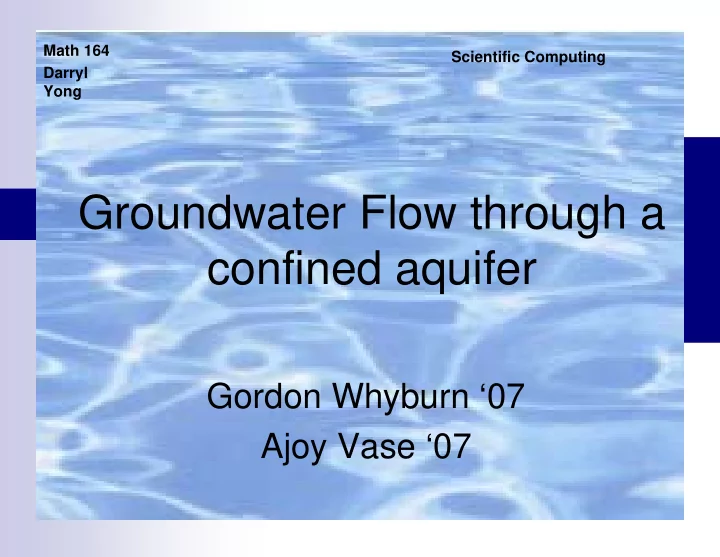

Math 164 Scientific Computing Darryl Yong Groundwater Flow through a confined aquifer Gordon Whyburn ‘07 Ajoy Vase ‘07
What is an aquifer? An aquifer is an underground layer of permeable material that allows a substantial amount of water to flow through it. Aquifers channel groundwater to wells. They can be made up of a variety of materials – gravel, sand, or clay. The local conductivity of an aquifer region dictates the flowrate of groundwater through it.
Unconfined aquifers Unconfined aquifers consist of layers of permeable rock from the bottom of the aquifer to the surface of the earth. No pressure � Recharge occurs from � above the aquifer and through lateral groundwater flow. Source: http://groundwater.orst.edu/
Confined Aquifers An aquifer is confined if it is surrounded by regions of impermeable rock. � Under pressure. � Recharge occurs primarily through lateral groundwater Source: http://groundwater.orst.edu/ flow.
What’s the big deal about aquifers? http://capp.water.usgs.gov/aquiferBasics/images/us_uncon-semi.gif � Important sources of freshwater. The Edwards aquifer in Texas supplies water for 2 million people. � Aquifer depletion is a global problem. � Solution - artificial recharge methods.
Our project We model the flow of water through a 2-D confined aquifer. Specific cases include: regions of differing conducitivity � Various initial flow situations � The governing equations for groundwater flow through an aquifer are: ∂ ∂ ∂ 2 2 h h h 1 h → hydraulic head + = ∂ ∂ ∂ 2 2 x y K t K → conductivity ∂ h q x → flow velocity = − q x K ∂ x ∂ h = − q y K ∂ y
Hydraulic head Hydraulic head is a measure of the pressure of the water in the aquifer. This pressure depends on the depth of the aquifer and the inherent water pressure. P = + h z ρ g
Solution Strategy dh/dy = 0 h 0 =H dh/dx = q 0 dh/dy = 0 Solve the main PDE for the head as a function of x and y using a finite difference grid. Find out the velocity of the water at different points in the grid by taking the derivative (numerically) of the head values with respect to x and y.
Results Case 1: Solving the steady state equation (Laplace equation)
Results Case 1: Solving the steady state equation (Laplace equation)
Results Results Case 2: Solution to Laplace’s equation for artificial injection
Results Results Case 2: Solution to Laplace’s equation for artificial injection 20 18 16 14 12 10 y 8 6 4 2 0 0 5 10 15 20 25 x
Results Results Case 3: Solution to Laplace’s Equation for flow along a slope
Results Results Case 3: Solution to Laplace’s Equation for flow along a slope 20 18 16 14 12 10 y 8 6 4 2 0 0 5 10 15 20 25 x
Results Case 4: Solving the original time dependent equation
Results Case 4: Solving the original time dependent equation
Further work Find out the flow for an aquifer with gradually changing conductivity. The steady state equation for this case is: ⎛ ⎞ ∂ ∂ ∂ ∂ ∂ ∂ 2 2 h h K h K h ⎜ ⎟ + + + = K ( x , y ) 0 ⎜ ⎟ ∂ ∂ ∂ ∂ ∂ ∂ 2 2 ⎝ ⎠ x y y y x x
References � C.W. Fetter, Applied Hydrogeology, Third Ed., Merill Publishing Company,1994 � Private Communication: � Dr. Richard Elderkin, Mathematics Dept., Pomona College � Dr. Linda Reinen, Geology Dept., Pomona College
Recommend
More recommend